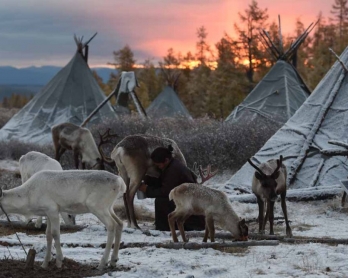Peeking into the past
Masai Mara Game Reserve, Kenya -- Living in Kenya, you have this incredible ability to witness things that on the whole look the same today as they did hundreds of years ago. It’s like peeking into the past. When the world is changing around you as much as ours is, it’s an incredible privilege to witness something like that.
It’s an amazing thing to go and see and I would certainly encourage anyone who has an opportunity to do so.
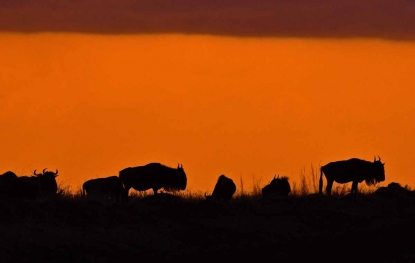 (AFP / Carl De Souza)
(AFP / Carl De Souza)This year marked my second photographing the annual wildebeest migration. They typically start from the Serengeti around July and they make it to the river crossings around August and then they cross back into the Serengeti from the Mara in September.
This year I spent four days in the Mara, catching them on their way back. I chose to camp in a public campground, so I didn’t need to hire rangers, who are required in private ones.
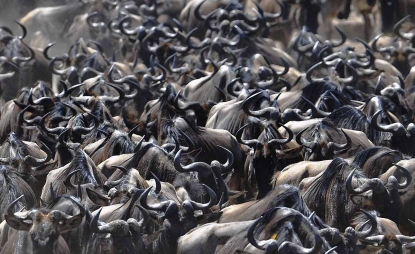 (AFP / Carl De Souza)
(AFP / Carl De Souza)This gave me an incredible amount of freedom, since I could come and go as I pleased and didn’t have to depend on anyone else for anything.
Plus, on a personal level, I love camping in nature. I love being there and sort of living around these animals. There is something so basic and exciting about doing that. When I’m in my tent at night, I hear the lions as they’re hunting nearby, I hear the hyenas. And when you’re on your own like that, you can have adventures to tell the grandkids about. But more on that later.
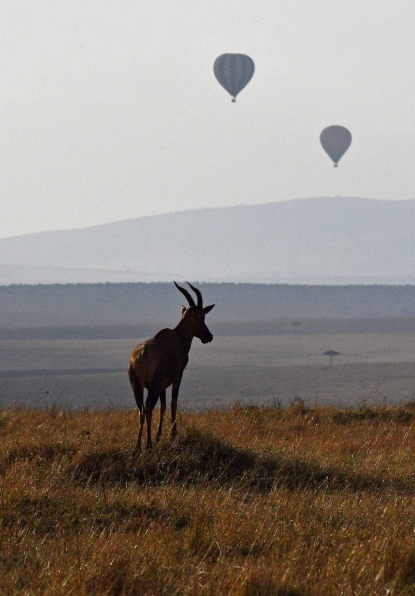 (AFP / Carl De Souza)
(AFP / Carl De Souza)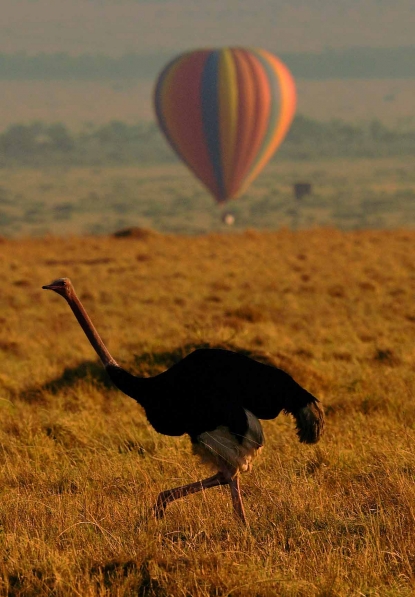 (AFP / Carl De Souza)
(AFP / Carl De Souza)
Camping on your own is also advantageous financially. If you stay at fancy lodges, it can end up costing quite a bit. But because I’m a resident here, they give us cheaper rates and camping costs aren’t really prohibitive.
Plus I’ve camped around Kenya now quite a lot, so I’m quite comfortable dealing with the wildlife on my own and I’m not so worried that I have to have guys with guns around me.
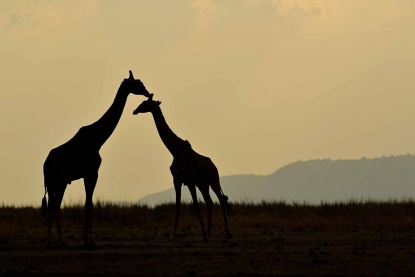 (AFP / Carl De Souza)
(AFP / Carl De Souza)I would begin my days just after 5 in the morning. I would get up, put the fire out, get all my equipment together, get into the car and go for a drive. The key with wildebeests is to get them when they’re crossing a river. It makes for some dramatic shots, plus the crocodiles are in the river waiting for them.
I know where the main crossing points are, so I would drive to one and just wait. You can see where the wildebeests are massing. But capturing them in action still involves quite a bit of driving and a bit of luck. Even if you see them massing somewhere, they will not necessarily cross.
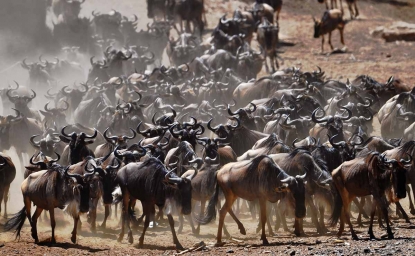 (AFP / Carl De Souza)
(AFP / Carl De Souza)They’re very skittish and not the most intelligent of animals. Even animal lovers and animal watchers agree on this point. They’re just not that intelligent. Sometimes they wait for a bottleneck to form right at the water’s edge and then one of them goes ahead and then the rest follow. Sometimes they just mass and noone goes ahead and they disperse. Sometimes they follow the zebras, as the zebras are better at spotting the crocodiles.
 Masai Mara, 2015. (AFP / Carl De Souza)
Masai Mara, 2015. (AFP / Carl De Souza)Each year, this part of Africa attracts thousands of tourists, who are a vital source of income to the parks here. Most of the tourists are fine, but some, well sometimes some of them can just ruin your day. I was camping and shooting on the Mara side, which is a conservation area. It’s more controlled and there are fewer cars. On the other side, it’s a bit of a zoo with all the tourist vehicles.
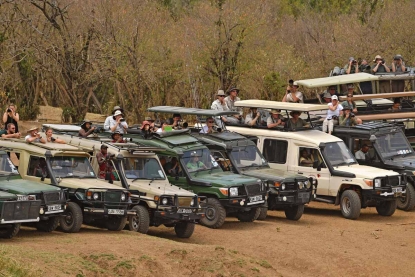 (AFP / Carl De Souza)
(AFP / Carl De Souza)Plus the problem is that many of these people are coming on their first and only safari. So understandably they’re very excited and they want to see as much as they can. So they ask to be driven all over the place. I get that excitement and impatience. But what people need to understand is that most of the time being patient pays off. If they realized that a bit more, they would have more enjoyment and they would probably see more wildlife. It’s not a theater show. Sometimes you just have to wait.
There is nothing more frustrating than having waited for five hours in the burning hot sun, waiting for the wildebeests to come and cross at a certain point and at the last moment, a huge truck with tourists comes driving up behind them, driving way too fast and scaring them all off. And you know the crossing won’t happen again for some time.
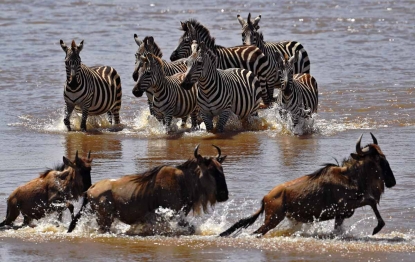 (AFP / Carl De Souza)
(AFP / Carl De Souza)This year was my crocodile shot year. These are fairly easy to get. If you have the patience. There are as many as 12 crocodiles waiting for the wildebeest to cross.
The crocodiles you find in the Mara are really huge. They are like super crocodiles. Which makes sense -- they have a big influx of food coming at them with every migration, and they can live up to 100 years. So these guys just feed and grow, feed and grow.
This year I got a good sequence of a crocodile attacking a wildebeest that really showed the size of them. What happened was that this crazy wildebeest came down and sat down by the river bed. The crocodile swam toward it. It still didn’t move. The crocodile launched at it, out of the water, but missed, and the wildebeest ran off. But then it came back to nose the crocodile, to see what it was. The crocodile went for it again and missed again. But I got some really nice shots of the crocodile launching out of the water; it was really nice to see a big crocodile like that.
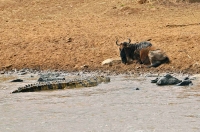
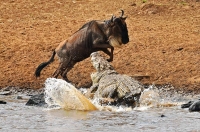
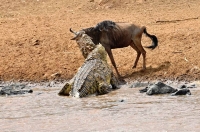
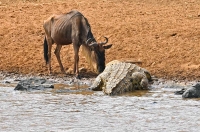
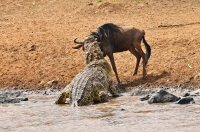
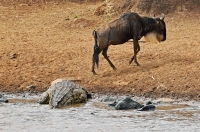
And then there was the sequence with the Thomson gazelle. When I saw a group of these gazelles come down to the water, I thought, “Oh, no, you guys are in trouble.” They were slipping on the river bank and some swam across because they couldn’t climb on the other side, and the crocodile just went for them. It was like plucking a convenient snack off a shelf.
These shots were dramatic, as I shot from the side and you can actually see the poor thing in the croc’s mouth. And that last shot, with its foot hanging out of its jaw, that also gives you a really good sense of just how big these things are.
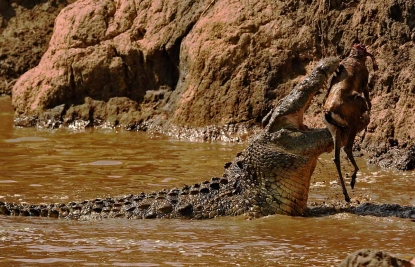 (AFP / Carl De Souza)
(AFP / Carl De Souza)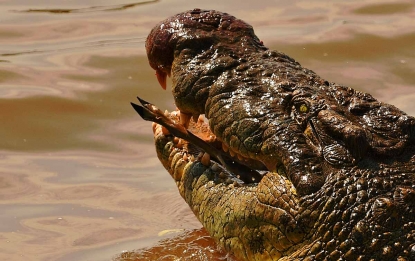 (AFP / Carl De Souza)
(AFP / Carl De Souza)
Although I concentrated on the wildebeests, I shot other things that were around as well, like the hot air balloons. And the lions. Which brings me back to my adventures.
 (AFP / Carl De Souza)
(AFP / Carl De Souza)It’s always crazy with the wildebeests; the lions are like in a sweetshop. It’s just so easy to kill them that the lions kill them but they don’t necessarily eat them. There are so many carcases on the side of the road. These guys are pretty well fed -- every time there is a migration, they’re pretty much guaranteed a meal.
 (AFP / Carl De Souza)
(AFP / Carl De Souza)During the night, I could hear the lions roaring and growling all around me. I wasn’t too worried. For one, they’re well fed -- no need to go after me in a tent when there’s plenty of wildebeests around. Secondly, I am always very careful never to leave any food at the campsite, but to put my ice box in the car for the night. They’re probably just hunting or they have just killed something.
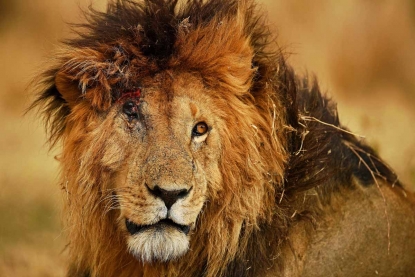 (AFP / Carl De Souza)
(AFP / Carl De Souza)So on one morning, I woke up and unzipped the tent. I am always very careful to look around me before stepping out. And on this particular morning I see this male lion in the bush. He was just walking along, but he was a bit too close for comfort. So I got in the car, turned on the lights, turned the engine on until he left. I didn’t wait around to photograph him.
The one I did get a nice shot of is a lion quite well known to the Mara rangers. His name is Scarface, because of the mark on his face. It never seems to heal completely. He’s definitely the star there.
I have to say that I loved this assignment. You end up being really tired, because you wait a lot, you drive a lot, you’re working from dawn to dusk, you end up being quite fatigued, because you always have to be ready and alert. But it’s an amazing thing to witness.
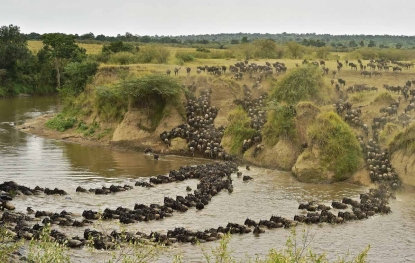 Wildebeests cross during the 2015 migration.
(AFP / Carl De Souza)
Wildebeests cross during the 2015 migration.
(AFP / Carl De Souza)Of course it’s controlled. And there are lots of trucks around filled with tourists. But you’re witnessing something that could have looked the same way hundreds of thousands of years ago. It’s a privilege.
This blog was written with Yana Dlugy in Paris.
 (AFP / Carl De Souza)
(AFP / Carl De Souza)





